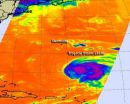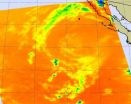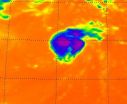(Press-News.org) The most-studied mass extinction in Earth history happened 65 million years ago and is widely thought to have wiped out the dinosaurs. New University of Washington research indicates that a separate extinction came shortly before that, triggered by volcanic eruptions that warmed the planet and killed life on the ocean floor.
The well-known second event is believed to have been triggered by an asteroid at least 6 miles in diameter slamming into Mexico's Yucatán Peninsula. But new evidence shows that by the time of the asteroid impact, life on the seafloor – mostly species of clams and snails – was already perishing because of the effects of huge volcanic eruptions on the Deccan Plateau in what is now India.
"The eruptions started 300,000 to 200,000 years before the impact, and they may have lasted 100,000 years," said Thomas Tobin, a UW doctoral student in Earth and space sciences.
The eruptions would have filled the atmosphere with fine particles, called aerosols, that initially cooled the planet but, more importantly, they also would have spewed carbon dioxide and other greenhouse gases to produce long-term warming that led to the first of the two mass extinctions.
"The aerosols are active on a year to 10-year time scale, while the carbon dioxide has effects on a scale of hundreds to tens of thousands of years," Tobin said.
During the earlier extinction it was primarily life on the ocean floor that died, in contrast to the later extinction triggered by the asteroid impact, which appeared to kill many more free-swimming species.
"The species in the first event are extinct but the groups are all recognizable things you could find around on a beach today," he said.
Tobin is the lead author of a paper in the journal Palaeogeography, Palaeoclimatology, Palaeoecology that documents results of research conducted in a fossil-rich area on Seymour Island, off the Antarctic Peninsula.
That particular area has very thick sediment deposits and, for a given interval of time, might contain 10 times more sediment as the well-known Hell Creek Formation in Montana. That means scientists have much greater detail as they try to determine what was happening at the time, Tobin said.
The researchers took small surface core samples from rocks and fossils in the Antarctic sediment and used a method called magnetostratigraphy, employing known changes over time in Earth's magnetic field to determine when the fossils were deposited. The thicker sediment allowed dating to be done more precisely.
"I think the evidence we have from this location is indicative of two separate events, and also indicates that warming took place," Tobin said.
There is no direct evidence yet that the first extinction event had any effect on the second, but Tobin believes it is possible that surviving species from the first event were compromised enough that they were unable to survive the long-term environmental effects of the asteroid impact.
"It seems improbable to me that they are completely independent events," he said.
INFORMATION:
The paper's coauthors are Peter Ward, Tobin's doctoral adviser, and Eric Steig, both UW professors of Earth and space sciences; Eduardo Olivero of the Southern Center for Scientific Research in Argentina; Isaac Hilburn, Matthew Diamond and Joseph Kirschvink of the California Institute of Technology; Ross Mitchell of Yale University; and Timothy Raub of the University of St. Andrews in Scotland.
The work was funded by the National Science Foundation Office of Polar Programs and the National Scientific and Technological Promotion Agency in Argentina.
For more information, contact Tobin at 813-545-1912 or ttobin@uw.edu.
Dinosaur die-out might have been second of 2 closely timed extinctions
2012-09-06
ELSE PRESS RELEASES FROM THIS DATE:
Social exclusion on the playground
2012-09-06
Montreal, September 5, 2012 – Being the last one picked for the team, getting left out of the clique of cool girls, having no one to sit with at lunch… For children, social exclusion can impact everything from emotional well being to academic achievements.
But what does it mean for the kids doing the excluding? Is the cure a one-size-fits-all approach that requires kids to include others, regardless of the situation at hand? Not necessarily, says new research from a professor now at Concordia University.
Unlike previous studies where researchers created hypothetical ...
Researchers identify biochemical functions for most of the human genome
2012-09-06
CAMBRIDGE, MA -- Only about 1 percent of the human genome contains gene regions that code for proteins, raising the question of what the rest of the DNA is doing. Scientists have now begun to discover the answer: About 80 percent of the genome is biochemically active, and likely involved in regulating the expression of nearby genes, according to a study from a large international team of researchers.
The consortium, known as ENCODE (which stands for "Encyclopedia of DNA Elements"), includes hundreds of scientists from several dozen labs around the world. Using genetic ...
NASA sees Tropical Storm Leslie was causing a problem for itself
2012-09-06
Infrared data from NASA's Aqua satellite shows that Tropical Storm Leslie has been causing problems for itself.
Tropical Storm Leslie has been on a slow track in the Atlantic, and because of that, the storm is kicking up cooler waters from below the ocean surface. Those cooler waters were seen in infrared imagery on Sept. 5 at 0611 UTC (2:11 a.m. EDT) taken by the Atmospheric Infrared Sounder (AIRS) instrument that flies aboard NASA's Aqua satellite. The cooler waters are responsible for Leslie's slow strengthening. Sea surface temperatures need to be at least as warm ...
NASA sees fading post-Tropical Cyclone John's warmer cloud tops
2012-09-06
Post-tropical cyclone John has been "flushed" out of existence in the eastern Pacific Ocean, and infrared NASA imagery revealed warmer cloud top temperatures and virtually no precipitation from John's remnants on Sept. 4.
When NASA's Aqua satellite flew over post-tropical storm John on Sept. 4 at 21:23 UTC (5:23 p.m. EDT) the Atmospheric Infrared Sounder (AIRS) instrument revealed that cloud top temperatures in the storm had warmed over the previous 24 hours. AIRS data also showed there was one very tiny area of convection (rising air that forms the thunderstorms that ...
Alternatives to Medicare's fee-for-service payment system examined
2012-09-06
For years policymakers have attempted to replace Medicare's fee-for- service payment system with approaches that pay one price for an aggregation of services. The intent has been to reward providers for offering needed care in the most appropriate and cost-effective manner. But many of these programs have known pitfalls, says Stuart Altman, an economist and the Sol C. Chaikin Professor of National Health Policy at the Heller School for Social Policy and Management, Brandeis University.
On Friday, Sept. 7, Altman and his Heller school colleague Robert Mechanic, will ...
NASA imagery reveals strength in Tropical Storm Michael's 'arm'
2012-09-06
NASA's Aqua satellite shows that tiny Tropical Storm Michael had some strong thunderstorms wrapped around its center and in a band of thunderstorms in its northeastern "arm" or quadrant.
The Atmospheric Infrared Sounder (AIRS) instrument that flies aboard NASA's Aqua satellite captured in infrared image of Tropical Storm Michael on Sept. 5 at 0611 UTC (2:11 a.m. EDT) and noticed the strongest thunderstorms and coldest cloud top temperatures around the center of circulation and in a band of thunderstorms to the northeast of Michael's center. Those cloud top temperatures ...
Popular kids in US and Mexico more likely to smoke, USC studies show
2012-09-06
Be warned, popularity may cause lung cancer, heart disease, and emphysema.
New research from the University of Southern California (USC) and University of Texas finds that popular students in seven Southern California high schools are more likely to smoke cigarettes than their less popular counterparts.
The study, which appears online this week in the Journal of Adolescent Health, confirms trends observed in previous USC-led studies of students in the sixth through 12th grades across the United States and in Mexico.
"That we're still seeing this association more ...
Bright life on the ocean bed: Predators may even color code food
2012-09-06
Sinking through the inky ocean, it would seem that there is little light at depth: but you'd be wrong. 'In the mesopelagic realm [200 m] bioluminescence [light produced by animals] is very common', says Sönke Johnsen from Duke University, USA, explaining that many creatures are capable of producing light, yet rarely do so. But how much light do the inhabitants of the ocean floor (benthos) generate? Explaining that some bioluminescence is generated when organisms collide, Johnsen says, 'In the benthos you have a current moving over complicated ground with all the things ...
Deep-sea crabs grab grub using UV vision
2012-09-06
DURHAM, N.C. -- Crabs living half-a-mile down in the ocean, beyond the reach of sunlight, have a sort of color vision combining sensitivity to blue and ultraviolet light.
Their detection of shorter wavelengths may give the crabs a way to ensure they grab food, not poison.
"Call it color-coding your food," said Duke biologist Sönke Johnsen. He explained that the animals might be using their ultraviolet and blue-light sensitivity to "sort out the likely toxic corals they're sitting on, which glow, or bioluminesce, blue-green and green, from the plankton they eat, which ...
Minimally invasive surgery works well for abdominal aortic aneurysms, Mayo finds
2012-09-06
ROCHESTER, Minn. -- A minimally invasive procedure known as endovascular repair used for abdominal aortic aneurysms has a low rate of complications, even in high-risk patients such as those with kidney, heart or lung problems, a Mayo Clinic study shows. Researchers found that even when aneurysms ruptured, endovascular repair had lower mortality rates than open-abdominal surgery, the other treatment option. The findings are being presented at the Midwestern Vascular Surgical Society Annual Meeting, Sept. 6-8, in Milwaukee, Wis.
An abdominal aortic aneurysm is a weakened ...



